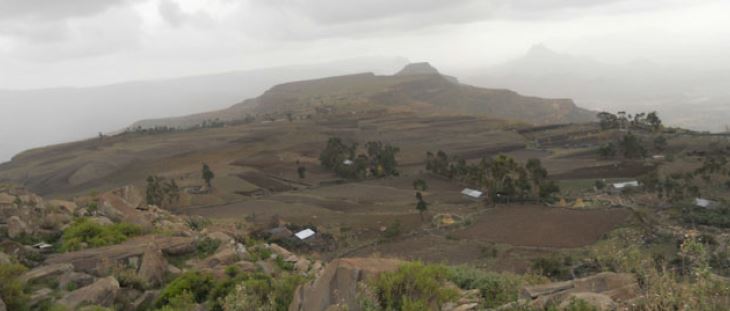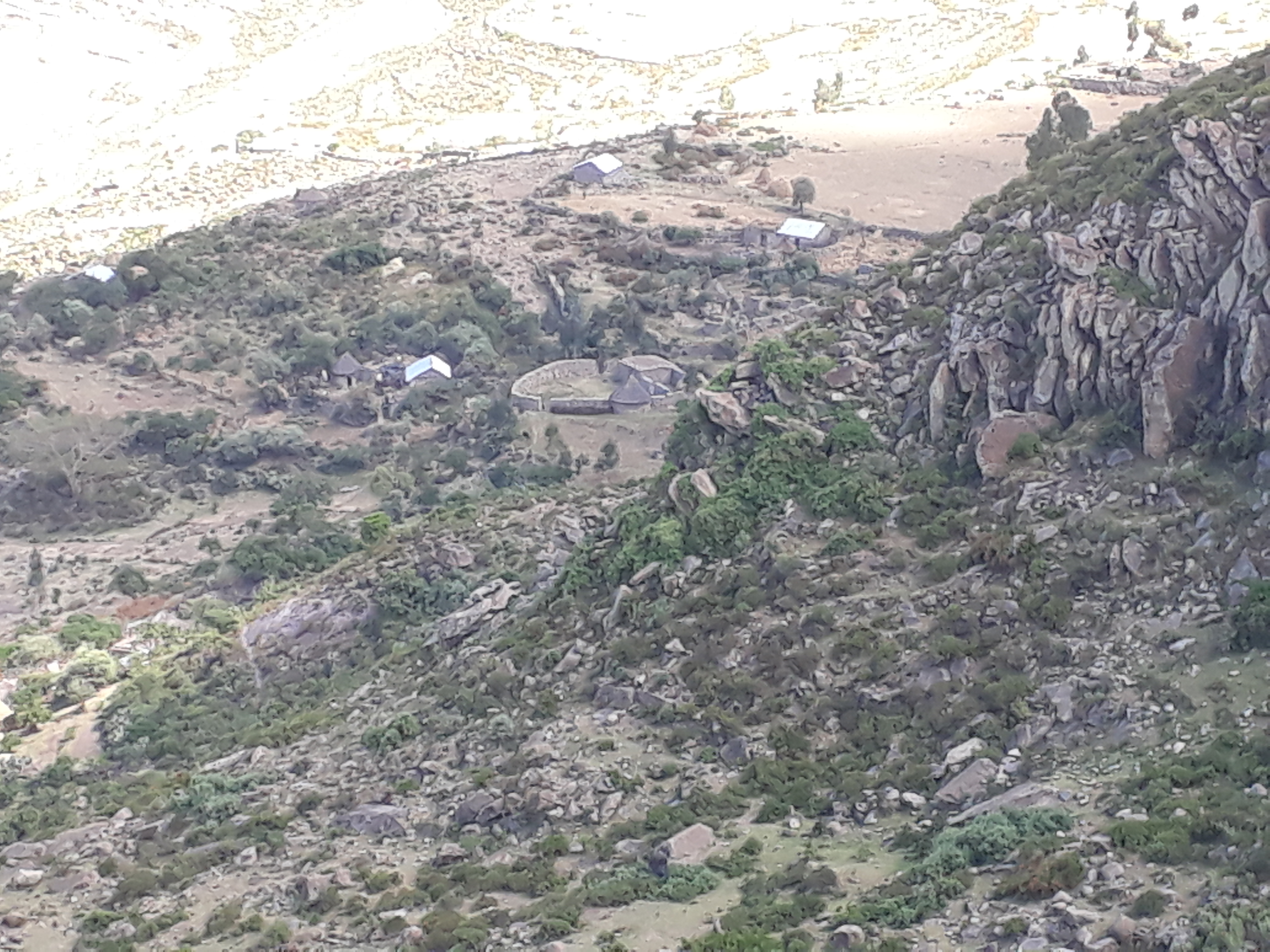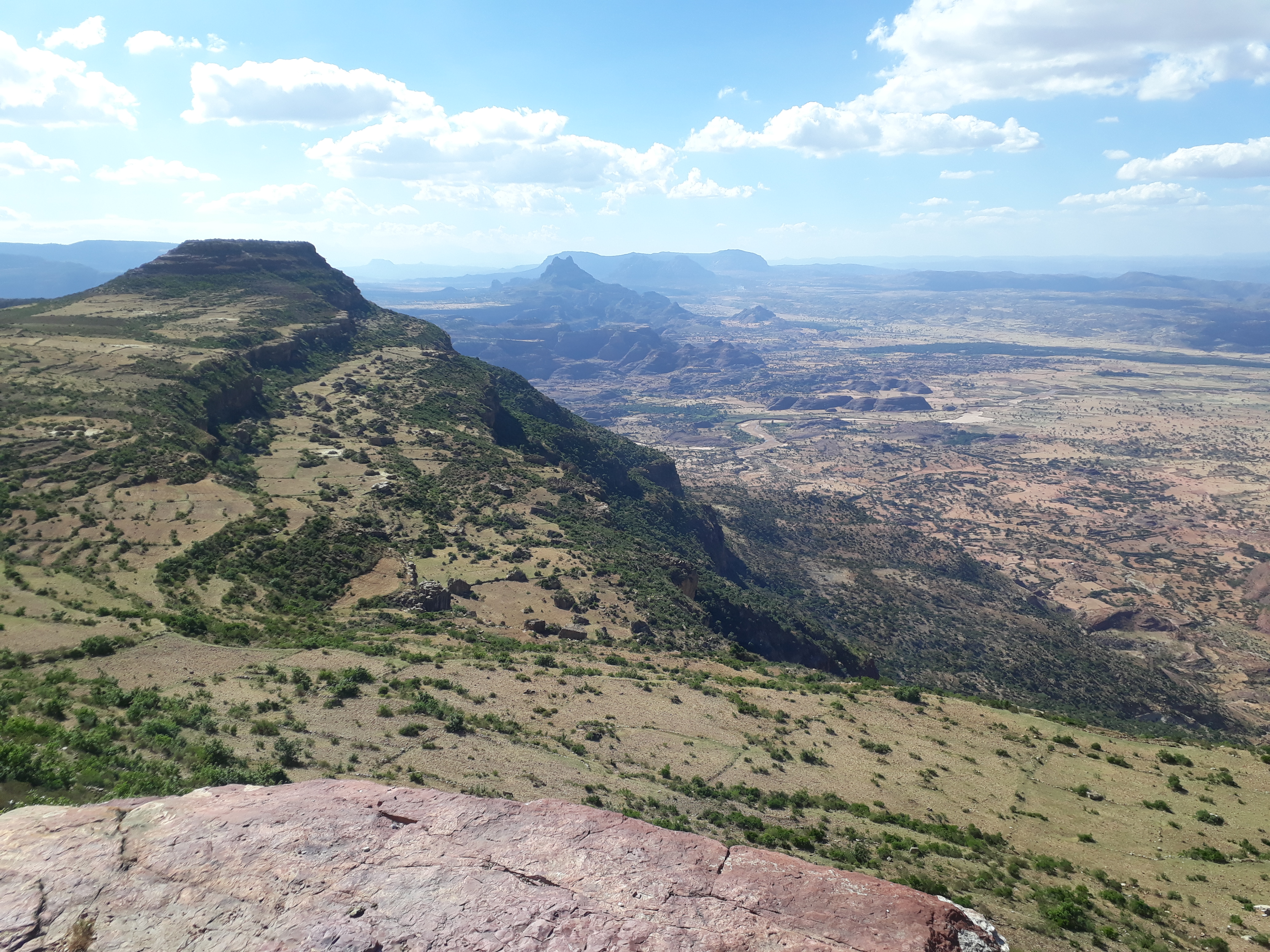Haddinnet on:
[Wikipedia]
[Google]
[Amazon]
Haddinnet, also transliterated as Hadnet, is a ''tabia'' or municipality in the 



 From the higher to the lower locations, the following geological formations are present:
* Phonolite plugs
* Upper basalt
* Interbedded lacustrine deposits
* Lower basalt
* Amba Aradam Formation
* Agula Shale
*
From the higher to the lower locations, the following geological formations are present:
* Phonolite plugs
* Upper basalt
* Interbedded lacustrine deposits
* Lower basalt
* Amba Aradam Formation
* Agula Shale
*








 The main road
The main road

File:View on Azef.jpg, View on Azef
File:Dabba Selama Mountain.jpg, Dabba Selama Mountain
File:Ksad Azef Mountain Pass.jpg, Ksad Azef Mountain Pass
File:Erica arborea on Dabba Selama Mountain.jpg,
Dogu'a Tembien
Dogu'a Tembien (, "Upper Tembien", sometimes transliterated as Degua Tembien) is a woreda in Tigray Region, Ethiopia. It is named in part after the former province of Tembien. Nowadays, the mountainous district is part of the Southeastern Tigray ...
district of the Tigray Region
The Tigray Region, officially the Tigray National Regional State, is the northernmost regional state in Ethiopia. The Tigray Region is the homeland of the Tigrayan, Irob, and Kunama people. Its capital and largest city is Mekelle. Tigray ...
of Ethiopia
Ethiopia, , om, Itiyoophiyaa, so, Itoobiya, ti, ኢትዮጵያ, Ítiyop'iya, aa, Itiyoppiya officially the Federal Democratic Republic of Ethiopia, is a landlocked country in the Horn of Africa. It shares borders with Eritrea to the ...
. The ''tabia'' centre is in Addi Idaga village, located approximately 6.5 km to the northeast of the ''woreda'' town Hagere Selam.

Geography
The ''tabia'' is located on the southern and northern slopes of the Tsili ridge in the northern part ofDogu'a Tembien
Dogu'a Tembien (, "Upper Tembien", sometimes transliterated as Degua Tembien) is a woreda in Tigray Region, Ethiopia. It is named in part after the former province of Tembien. Nowadays, the mountainous district is part of the Southeastern Tigray ...
. The highest peak is Dabba Selama (2630 m a.s.l.) (not to be confounded with the homonymous monastery) and the lowest place along Agefet River (1720 m a.s.l.).


Geology

 From the higher to the lower locations, the following geological formations are present:
* Phonolite plugs
* Upper basalt
* Interbedded lacustrine deposits
* Lower basalt
* Amba Aradam Formation
* Agula Shale
*
From the higher to the lower locations, the following geological formations are present:
* Phonolite plugs
* Upper basalt
* Interbedded lacustrine deposits
* Lower basalt
* Amba Aradam Formation
* Agula Shale
* Antalo Limestone
The Antalo Limestone, also known as the Antalo Sequence, is a geological formation in Ethiopia. It is between 300 and 800 metres thick and comprises fossiliferous limestones and marls that were deposited in a reef. Marine microfossils have shown ...
* Adigrat Sandstone
The Adigrat Sandstone formation in north Ethiopia, in a wide array of reddish colours, comprises sandstones with coarse to fine grains, and locally conglomerates, silt- and claystones. Given the many lateritic palaeosols and locally fossil wood ...
* Edaga Arbi Glacials
The Edaga Arbi Glacials are a Palaeozoic geological formation in Tigray (northern Ethiopia) and in Eritrea. The matrix is composed of grey, black and purple clays (locally silt), that contains rock fragments up to 6 metres across. Pollen dating ...
* Quaternary alluvium
Alluvium (from Latin ''alluvius'', from ''alluere'' 'to wash against') is loose clay, silt, sand, or gravel that has been deposited by running water in a stream bed, on a floodplain, in an alluvial fan or beach, or in similar settings. ...
and freshwater tufa
Tufa is a variety of limestone formed when carbonate minerals precipitate out of water in unheated rivers or lakes. Geothermally heated hot springs sometimes produce similar (but less porous) carbonate deposits, which are known as travertin ...
Climate
The rainfall pattern shows a very high seasonality with 70 to 80% of the annual rain falling in July and August. Mean temperature in Addi Idaga is 20.4 °C, oscillating between average daily minimum of 11.5 °C and maximum of 28.9 °C. The contrasts between day and night air temperatures are much larger than seasonal contrasts.
Springs
As there is very poor baseflow in the permanent rivers, the presence of springs is of utmost importance for the local people. The main springs in the ''tabia'' are: * Ruba Weyni, fed by seepage fromMay Leiba
May Leiba is a reservoir located in the Dogu’a Tembien ''woreda'' of the Tigray Region in Ethiopia. It is named after the May Leiba River. The earthen dam that holds the reservoir was built in 1998 by the Relief Society of Tigray.
Dam char ...
reservoir
* May Damo in Atsa
* Abune Ayezgi in Debre Medhanit
Reservoirs
In this area with rains that last only for a couple of months per year, reservoirs of different sizes allow harvesting runoff from the rainy season for further use in the dry season. Overall they suffer from siltation. Yet, they strongly contribute to greening the landscape, either through irrigation or seepage water. Main reservoirs are: *May Leiba
May Leiba is a reservoir located in the Dogu’a Tembien ''woreda'' of the Tigray Region in Ethiopia. It is named after the May Leiba River. The earthen dam that holds the reservoir was built in 1998 by the Relief Society of Tigray.
Dam char ...
reservoir, in Ayninbirkekin ''tabia'', constructed in 1998
* Traditional surface water harvesting ponds, particularly in places without permanent springs, called ''rahaya''
* ''Horoyo'', household ponds, recently constructed through campaigns
Vegetation and exclosures
The ''tabia'' holds severalexclosure
An exclosure, in an area being used extensively for grazing, is a limited area from which unwanted browsing animals, such as domestic cattle or wildlife such as deer, are excluded by fencing or other means.
Environmental protection
Most commonl ...
s, areas that are set aside for regreening. Wood harvesting and livestock range are not allowed there. Besides effects on biodiversity
Biodiversity or biological diversity is the variety and variability of life on Earth. Biodiversity is a measure of variation at the genetic (''genetic variability''), species (''species diversity''), and ecosystem (''ecosystem diversity'') l ...
, water infiltration
Infiltration is the process by which water on the ground surface enters the soil. It is commonly used in both hydrology and soil sciences. The infiltration capacity is defined as the maximum rate of infiltration. It is most often measured in meter ...
, protection from flooding, sediment
Sediment is a naturally occurring material that is broken down by processes of weathering and erosion, and is subsequently transported by the action of wind, water, or ice or by the force of gravity acting on the particles. For example, sa ...
deposition, carbon sequestration
Carbon sequestration is the process of storing carbon in a carbon pool. Carbon dioxide () is naturally captured from the atmosphere through biological, chemical, and physical processes. These changes can be accelerated through changes in lan ...
, people commonly have economic benefits from these exclosures through grass harvesting, beekeeping and other non-timber forest product
Non-timber forest products (NTFPs) are useful foods, substances, materials and/or commodities obtained from forests other than timber. Harvest ranges from wild collection to farming. They typically include game animals, fur-bearers, nuts, see ...
s. The local inhabitants also consider it as “land set aside for future generations”.


Settlements
The ''tabia'' centre Addi Idaga holds a few administrative offices, a health post, a primary school, and some small shops. Saturday is the market day. There are a few more primary schools across the ''tabia''. The main other populated places are:
Agriculture and livelihood
The population lives essentially from crop farming, supplemented with off-season work in nearby towns. The land is dominated byfarmland
Agricultural land is typically land ''devoted to'' agriculture, the systematic and controlled use of other forms of lifeparticularly the rearing of livestock and production of cropsto produce food for humans. It is generally synonymous with bo ...
s which are clearly demarcated and are cropped every year. Hence the agricultural system
Agriculture or farming is the practice of cultivating plants and livestock. Agriculture was the key development in the rise of sedentary human civilization, whereby farming of domesticated species created food surpluses that enabled people to ...
is a permanent upland farming system. The farmers have adapted their cropping system The term cropping system refers to the crops, crop sequences and management techniques used on a particular agricultural field over a period of years. It includes all spatial and temporal aspects of managing an agricultural system. Historically, cro ...
s to the spatio-temporal variability in rainfall. Large irrigated lands have been established in Addi Idaga. The youngsters of the ''tabia'' have established wide grasslands on mountain ridges; the grass is mainly sold for thatching.
History and culture

History
The history of the ''tabia'' is strongly confounded with the history of Tembien. In the 1930s, during the Italian invasion, Ksad Azef () was an important battlefield during theFirst Battle of Tembien
The First Battle of Tembien was a battle fought on the northern front of what was known as the Second Italo-Ethiopian War. This battle consisted of attacks and counterattacks by Italian forces under Marshal Pietro Badoglio and Ethiopian forc ...
. It is a place through which the Tembien highlands could relatively easily be accessed when coming from the Gheralta lowlands. The Italians called it Passo Abaro. Italian ''Blackshirt
The Voluntary Militia for National Security ( it, Milizia Volontaria per la Sicurezza Nazionale, MVSN), commonly called the Blackshirts ( it, Camicie Nere, CCNN, singular: ) or (singular: ), was originally the paramilitary wing of the Nation ...
'' soldiers left a memorial stone on top of the nearby Mount Dabba Selama.


Religion and churches
Most inhabitants are Orthodox Christians. The following churches are located in the ''tabia'':
''Inda Siwa'', the local beer houses
In the main villages, there are traditional beer houses ('' Inda Siwa''), often in unique settings, which are a good place for resting and chatting with the local people. The most renown in the ''tabia'' are all located in the ''tabia'' centre Addi Idaga: * Yergalem Assefa * Mulubrhan Hagos * Mihret AbrhaRoads and communication
 The main road
The main road Mekelle
Mekelle ( ti, መቐለ, am, መቀሌ, mäqälle, mek’elē) or Mekele is a special zone and capital of the Tigray Region of Ethiopia. Mekelle was formerly the capital of Enderta awraja in Tigray. It is located around north of the Ethiopi ...
– Hagere Selam – Abiy Addi
Abiy Addi (also spelled Abi Addi; Tigrigna ዓብዪ ዓዲ "Big town") is a town in central Tigray, Ethiopia. Abiy Addi is at the southeastern edge of the Kola Tembien woreda, of which it is the capital.
Overview
The town is divided into t ...
runs 5–10 km south of the ''tabia''. People need to walk long distances to catch a bus. Further, a rural access road links most villages to the main asphalt road.
Tourism
Its mountainous nature and proximity toMekelle
Mekelle ( ti, መቐለ, am, መቀሌ, mäqälle, mek’elē) or Mekele is a special zone and capital of the Tigray Region of Ethiopia. Mekelle was formerly the capital of Enderta awraja in Tigray. It is located around north of the Ethiopi ...
makes the ''tabia'' fit for tourism.
Touristic attractions
* Tsili ridge * Tinsehe waterfall * Dabba Selama mountain, withErica arborea
''Erica arborea'', the tree heath or tree heather, is a species of flowering plant (angiosperms) in the heather family Ericaceae, native to the Mediterranean Basin and Ethiopia, Kenya and Tanzania in East Africa. It is also cultivated as an o ...
forest, church, and a memorial stone of the 1930s, left by soldiers of the Italian army, a metres-wide phonolite with inscriptions.
* Kidane Mihret rock church in Ab'aro, surrounded by tufa
Tufa is a variety of limestone formed when carbonate minerals precipitate out of water in unheated rivers or lakes. Geothermally heated hot springs sometimes produce similar (but less porous) carbonate deposits, which are known as travertin ...
plugs, springs and a cluster of trees. The church was established in widened caves of the tufa plug.
Geotouristic sites
The high variability of geological formations and the rugged topography invites for geological and geographic tourism or "geotourism". Geosites in the ''tabia'' include:Birdwatching
Birdwatching
Birdwatching, or birding, is the observing of birds, either as a recreational activity or as a form of citizen science. A birdwatcher may observe by using their naked eye, by using a visual enhancement device like binoculars or a telescope, by ...
(for the species, see the main Dogu'a Tembien
Dogu'a Tembien (, "Upper Tembien", sometimes transliterated as Degua Tembien) is a woreda in Tigray Region, Ethiopia. It is named in part after the former province of Tembien. Nowadays, the mountainous district is part of the Southeastern Tigray ...
page) can be done particularly in exclosures and forests. The Wehabit Sillasie church forest bird-watching site is particularly interesting.

Trekking routes
Trekking routes have been established in this ''tabia''. The tracks are not marked on the ground but can be followed using downloaded .GPX files. * Trek 21, along the northern side ofTsaliet
Tsaliet is a river in northern Ethiopia, belonging to the Nile basin. Rising in the mountains of Dogu’a Tembien, where it is first called May Leiba River and then Tinsehe River, it flows westward through a deep gorge, to become Tsaliet in its ...
gorge up to Addi Hamushenai, and further down to Addeha in Kola Tembien
* Trek 23 to the top of Dabba Selama mountain
* Trek 26, over the top of Tsili ridge
* Trek Gh2, from Addi Idaga, down to Gheralta, along the Ab'aro rock church
Accommodation and facilities
The facilities are very basic. One may be invited to spend the night in a rural homestead or ask permission to pitch a tent. Hotels are available in Hagere Selam andMekelle
Mekelle ( ti, መቐለ, am, መቀሌ, mäqälle, mek’elē) or Mekele is a special zone and capital of the Tigray Region of Ethiopia. Mekelle was formerly the capital of Enderta awraja in Tigray. It is located around north of the Ethiopi ...
.
More detailed information
For more details on environment, agriculture, rural sociology, hydrology, ecology, culture, etc., see the overall page on theDogu'a Tembien
Dogu'a Tembien (, "Upper Tembien", sometimes transliterated as Degua Tembien) is a woreda in Tigray Region, Ethiopia. It is named in part after the former province of Tembien. Nowadays, the mountainous district is part of the Southeastern Tigray ...
district.
Gallery
Erica arborea
''Erica arborea'', the tree heath or tree heather, is a species of flowering plant (angiosperms) in the heather family Ericaceae, native to the Mediterranean Basin and Ethiopia, Kenya and Tanzania in East Africa. It is also cultivated as an o ...
on Dabba Selama Mountain
References
{{ Tabias (municipalities) of Dogu’a Tembien Dogu'a Tembien Populated places in the Tigray Region